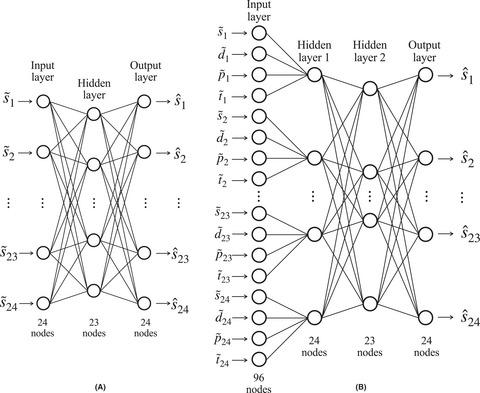当前位置:
X-MOL 学术
›
Energy Sci. Eng.
›
论文详情
Our official English website, www.x-mol.net, welcomes your feedback! (Note: you will need to create a separate account there.)
Multivariable neural network to postprocess short-term, hub-height wind forecasts
Energy Science & Engineering ( IF 3.8 ) Pub Date : 2021-06-10 , DOI: 10.1002/ese3.928 Andrés A. Salazar 1 , Yuzhang Che 1, 2 , Jiafeng Zheng 2 , Feng Xiao 1
Energy Science & Engineering ( IF 3.8 ) Pub Date : 2021-06-10 , DOI: 10.1002/ese3.928 Andrés A. Salazar 1 , Yuzhang Che 1, 2 , Jiafeng Zheng 2 , Feng Xiao 1
Affiliation

|
This work introduces a novel error correction method for short-term, hub-height wind speed forecasting systems aimed at power output prediction. We present a multivariable neural network that is trained to reduce the error in wind speed predictions out of a numerical weather prediction (NWP) model, by exploiting hidden information in additional atmospheric variables, that is, wind direction, temperature, and pressure. The unique layout of the network was influenced by that of denoising autoencoders, and their ability to learn mapping functions. The predicted values from the NWP model, which incorporate errors due to numerical discretization, inaccuracies in initial/boundary conditions and parametrizations, complex terrain features, etc., are mapped to a more accurate prediction in which the errors have been reduced. To show the performance of the proposed model, training and validation are carried out with 4 years of forecasted and observed data for fifteen sites in a wind farm in Awaji Island, Japan, in a challenging zone with complex topography and therefore complicated, highly fluctuating wind patterns. Moreover, a single variable (i.e., wind speed) network is also implemented in order to expose the contribution and usefulness of including additional atmospheric variables. The results show a considerable reduction in the root mean square error as well as an increase in the correlation coefficient. As expected, it is found that multiple meteorological variables as inputs offer a huge advantage when compared with the equivalent single-variable correction method.
中文翻译:

用于后处理短期、轮毂高度风预测的多变量神经网络
这项工作为针对功率输出预测的短期、轮毂高度风速预测系统引入了一种新颖的误差校正方法。我们提出了一个多变量神经网络,该网络经过训练可以通过利用附加大气变量(即风向、温度和压力)中的隐藏信息来减少数值天气预报 (NWP) 模型中风速预测的误差。网络的独特布局受到去噪自编码器的影响,以及它们学习映射函数的能力。NWP 模型的预测值包含由于数值离散化、初始/边界条件和参数化不准确、复杂地形特征等导致的误差,被映射为更准确的预测,其中误差已减少。为了展示所提出的模型的性能,对日本淡路岛风电场的 15 个站点进行了为期 4 年的预测和观测数据的训练和验证,该站点位于具有复杂地形的具有挑战性的区域,因此具有复杂的、高度波动的风模式。此外,还实施了单个变量(即风速)网络,以揭示包括额外大气变量的贡献和有用性。结果显示均方根误差显着降低,相关系数增加。正如预期的那样,与等效的单变量校正方法相比,作为输入的多个气象变量提供了巨大的优势。培训和验证是在日本淡路岛的一个风电场的 15 个站点的 4 年预测和观测数据中进行的,该风电场位于具有复杂地形的具有挑战性的区域,因此具有复杂的、高度波动的风模式。此外,还实施了单个变量(即风速)网络,以揭示包括额外大气变量的贡献和有用性。结果显示均方根误差显着降低,相关系数增加。正如预期的那样,与等效的单变量校正方法相比,作为输入的多个气象变量提供了巨大的优势。培训和验证是在日本淡路岛的一个风电场的 15 个站点的 4 年预测和观测数据中进行的,该风电场位于具有复杂地形的具有挑战性的区域,因此具有复杂的、高度波动的风模式。此外,还实施了单个变量(即风速)网络,以揭示包括额外大气变量的贡献和有用性。结果显示均方根误差显着降低,相关系数增加。正如预期的那样,与等效的单变量校正方法相比,作为输入的多个气象变量提供了巨大的优势。高度波动的风型。此外,还实施了单个变量(即风速)网络,以揭示包括额外大气变量的贡献和有用性。结果显示均方根误差显着降低,相关系数增加。正如预期的那样,与等效的单变量校正方法相比,作为输入的多个气象变量提供了巨大的优势。高度波动的风型。此外,还实施了单个变量(即风速)网络,以揭示包括额外大气变量的贡献和有用性。结果显示均方根误差显着降低,相关系数增加。正如预期的那样,与等效的单变量校正方法相比,作为输入的多个气象变量提供了巨大的优势。
更新日期:2021-06-10
中文翻译:

用于后处理短期、轮毂高度风预测的多变量神经网络
这项工作为针对功率输出预测的短期、轮毂高度风速预测系统引入了一种新颖的误差校正方法。我们提出了一个多变量神经网络,该网络经过训练可以通过利用附加大气变量(即风向、温度和压力)中的隐藏信息来减少数值天气预报 (NWP) 模型中风速预测的误差。网络的独特布局受到去噪自编码器的影响,以及它们学习映射函数的能力。NWP 模型的预测值包含由于数值离散化、初始/边界条件和参数化不准确、复杂地形特征等导致的误差,被映射为更准确的预测,其中误差已减少。为了展示所提出的模型的性能,对日本淡路岛风电场的 15 个站点进行了为期 4 年的预测和观测数据的训练和验证,该站点位于具有复杂地形的具有挑战性的区域,因此具有复杂的、高度波动的风模式。此外,还实施了单个变量(即风速)网络,以揭示包括额外大气变量的贡献和有用性。结果显示均方根误差显着降低,相关系数增加。正如预期的那样,与等效的单变量校正方法相比,作为输入的多个气象变量提供了巨大的优势。培训和验证是在日本淡路岛的一个风电场的 15 个站点的 4 年预测和观测数据中进行的,该风电场位于具有复杂地形的具有挑战性的区域,因此具有复杂的、高度波动的风模式。此外,还实施了单个变量(即风速)网络,以揭示包括额外大气变量的贡献和有用性。结果显示均方根误差显着降低,相关系数增加。正如预期的那样,与等效的单变量校正方法相比,作为输入的多个气象变量提供了巨大的优势。培训和验证是在日本淡路岛的一个风电场的 15 个站点的 4 年预测和观测数据中进行的,该风电场位于具有复杂地形的具有挑战性的区域,因此具有复杂的、高度波动的风模式。此外,还实施了单个变量(即风速)网络,以揭示包括额外大气变量的贡献和有用性。结果显示均方根误差显着降低,相关系数增加。正如预期的那样,与等效的单变量校正方法相比,作为输入的多个气象变量提供了巨大的优势。高度波动的风型。此外,还实施了单个变量(即风速)网络,以揭示包括额外大气变量的贡献和有用性。结果显示均方根误差显着降低,相关系数增加。正如预期的那样,与等效的单变量校正方法相比,作为输入的多个气象变量提供了巨大的优势。高度波动的风型。此外,还实施了单个变量(即风速)网络,以揭示包括额外大气变量的贡献和有用性。结果显示均方根误差显着降低,相关系数增加。正如预期的那样,与等效的单变量校正方法相比,作为输入的多个气象变量提供了巨大的优势。



























 京公网安备 11010802027423号
京公网安备 11010802027423号